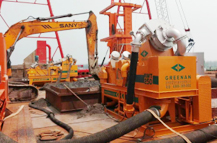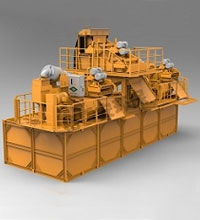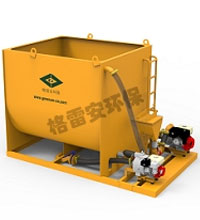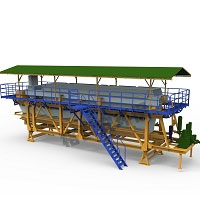"Mud stagnation" processing technology leading the development has become a consensus
Release time:2017/3/27 16:33:43 Clicks:3594
takeaway
As of March 2016, our country has built more than 3910 town sewage treatment plants, sewage treatment capacity has reached 167 million cubic meters/day. As derivatives of sewage, our country each year 30 million tons to 40 million tons of municipal sludge (moisture content 80%). "Chinese academy of engineering, li-an hou said predicts 2020, the municipal sludge output will reach 60 million tons to 60 million tons.
In recent years, our country issued a series of policies and measures, promoting the development of sludge disposal industry. Among them, the dispose of sludge, the sludge effective utilization of resources, improve the efficiency of treatment and reduce the disposal cost into the industry's attention hot spot.

The definition and classification of sludge treatment
1. The definition of sludge:
Sludge treatment (suldge treatment: the fouling secrete mud for enrichment, modulation, dehydration, stability, drying or burning process.
2. The classification of the sludge:
Sludge treatment before, first of all to understand the classification of the sludge, to determine methods of sludge treatment:

Sludge treatment steps

1 enrichment
First of all, the original sludge through sludge pump by the second pond, playing in the pool to another by and supernatant fluid separation. Because the moisture content of the original sludge usually can reach 99.5%, so the sludge must be concentrated, there are several feasible methods are used to reduce the volume of sludge.
Such as vacuum filter and centrifugal mechanical processing method is usually used for sludge disposal in semi-solid form before. These methods are usually the sludge incineration of the preparation. If you are planning to adopt biological treatment, the majority to use gravity sedimentation or flotation method for enrichment. In both cases of the sludge is still flow.
The design and operation of gravity concentration pool is similar to the second sewage treatment pond. Enrichment function is the main design parameters, in order to meet greater enrichment capability, concentrated tank basically is deep than the second pond. A design is correct, well-run gravity concentration pool can improve the sludge silt content of two times at least.
That is to say, the moisture content of sludge can be reduced to 99.5% and 98%, or less. Here it is worth mentioning that the design of gravity concentration pool is based on the analysis of Chinese style results as far as possible, because the right sludge load rate and the properties of the sludge has a lot to do.
If the dissolved air air float enrichment, needs to have a small amount of water, is usually the second pond water, under the pressure of 400 kpa. This supersaturated liquid into the tank bottom, and the sludge through under atmospheric pressure. Gas and solid particles in the sludge in the form of small bubbles stick, or is surrounded, thus promote solid particles floating to the surface. Enrichment be eliminated in the upper part of the sludge, and the liquid flow back to the dissolving tank at the bottom of the inflatable.
2 the degradation digestion
Volume decreases, the sludge contains a lot of harmful ingredients, need to be converted to the inert ingredients before disposal. Biodegradation is the most commonly used method is stable. Because this process is aimed at converting material to final sterile product, so often used digestion method. Sludge digestion can further reduce the sludge volume can also contain solid into inert substances and no general germs. Through anaerobic digestion or good digestion can achieve sludge digestion.
Sludge contains a variety of organic matter, so we need a variety of microorganisms to break down. Information about anaerobic digestion of microorganisms can be divided into two categories: produce acid bacteria and methane bacteria. So, we also can get a two-stage anaerobic digestion.
The first step, composed of facultative anaerobic bacteria and anaerobic bacteria produce acid bacteria by hydrolysis of organic dissolved solids. The fermentation and then dissolved organic matter into alcohol and low molecular weight molecules.
The second step, there are strict anaerobic bacteria of methane bacteria acetic acid, alcohol, water and carbon dioxide can be converted to methane. Because the two kinds of bacteria can survive in the anaerobic environment, so the anaerobic digestion reactor must be closed. When design the container at the same time also want to consider other factors, such as temperature, pH and stir the mixture.
But can be by aerobic digestion sludge stability. This digest basically can only be used for biochemical sludge can and cannot be used for early pond sludge, accompanied by the second pond in the sludge thickener and sludge volume reduction, this process requires constant courage. Aerobic digestion more aeration system used in depth. Moreover, aerobic digestion is not sensitive to environmental conditions, also has popular change is not limited.
3 disposal
After sludge digestion, organic matter in sludge can be removed and can further reduce the sludge volume. Next, the need to dispose of sludge. Many methods can be used for effective disposal of sludge. Including incineration and sanitary landfill and used as fertilizer and soil conditioner. The original sludge can be used to burn, can effectively reduce the moisture content. Add fuel can be used to cause and maintain combustion, city garbage can also be used to achieve this goal. The original sludge and digested sludge can also use sanitary landfill to deal with.
Sludge land application practice for years, and now only handle digested sludge. Sludge nutrients for plants to grow, and the particle characteristics can be used for land reclamation. The application limitation feed crops and human consumption, and applied to support the possibility of edible plants are being studied. Land application of sludge enrichment of main limiting factor for plant metal toxicity and the water eutrophication pollution. The application of sludge can be in the flow by the sprinkler spray, ditch diversion or injected directly into the soil. By traditional agricultural machinery to water sludge can be laid on land and cultivate the soil.
Advantages and disadvantages of several sludge treatment methods and analysis

1 the sludge sanitary landfill
This kind of disposal method is simple and easy, low cost, and does not need high sludge dewatering, strong adaptability. But sludge landfill, there are some problems, especially the landfill leachate and the formation of gas. Leachate is a kind of serious pollution of the liquid, if the landfill site selection or improper operation will pollute the groundwater environment. Landfill gas is mainly methane, if do not take appropriate measures will cause burning and explosion.
2 sludge land use directl
Sludge land use directly because of less investment, low energy consumption, low operating cost, the advantages of organic composition of parts can be converted into soil conditioner, is regarded as the most development potential of a way of disposal, scientific and reasonable land use, can reduce the negative effects on the sludge. Forest land and the use of city greening because not easy to cause the pollution of food chain and become a way of sludge land use. Sludge used in severe disturbance of land (such as land mines, deforestation, landfills, the surface damage area such as reclamation of land) of the repair and reconstruction, potential threat to human life, reduce the sludge disposal of the sludge and recover the ecological environment.
3 the sludge incineration
Wet sludge drying after direct burning are more widely used, not only directly without drying sludge incineration is very difficult, and is also highly economic on energy consumption.
With incineration as the core of sludge treatment method is one of the most complete sludge treatment method, it can make all organic matter, carbide kill pathogens, can minimize sludge volume; Investment is big, but its weakness is that treatment facilities of the high cost of processing, equipment maintenance cost is high, and have strong carcinogen dioxin.
New technology of sludge treatment
1 free disposal
The sludge washing technology on technology innovation, first to wash out the organic matter in sludge, sludge soil separation of inorganic substances, then organic sludge concentration to high temperature anaerobic digestion process.
Precipitation sludge after washing wash out half of the sludge of solid inorganic sludge soil, reduce the amount of half biological processing, save the project investment and the processing costs;In addition to the individual treatment organic sludge, inorganic sludge soil sedimentation in the reactor, reduce the wear and reactor equipment maintenance;Precipitation sludge after washing washing out the most easy to precipitate heavy metals and inorganic sludge in sewage sludge soil, improve the quality of organic fertilizer; Soil washing out the sludge can also produce pavement encaustic brick, permeable brick.
Other process innovation: ultra high temperature anaerobic digestion, multi-stage anaerobic digestion, renewal, such as floating sludge biological treatment speed increased by several times and biogas production increased by more than 20%.
Precipitation sludge biological treatment systems, engineering design innovation the buried, gripping, multistage digestion reactor design, several independent sometimes-complex mix-and-match of anaerobic digestion reactor, I have you in one integrated mass, save construction materials, the low cost of concrete structure.
Existing anaerobic digestion reactor at home and abroad widely used structure on the ground, the ground structure can make a device to facilitate maintenance and renewal emission prevention renewal precipitation.
The biological treatment system of engineering design well solved the precipitation, form a complete set of equipment maintenance and renewal system equipped with less equipment, only need a few pumps, pump is broken to replace a 20 minutes to burn, ensure equipment maintenance shutdown; After washing removed easily precipitation precipitation sludge inorganic sludge soil, organic sludge floating through all blow system not precipitation. Buried anaerobic digestion reactor less investment, not only do not take up the land, but also can prevent earthquakes, lightning protection and long service life, reduce the heat losses in the digestive system.
In order to design a day processing 600 tons of water content of 80% of the precipitation sludge washing, biological treatment plant as an example, the processing power, sludge moisture content with dalian Xia Guhe sludge treatment plant (2010 national demonstration project first) are exactly the same, need only 20% compared with investment.
Plant daily operation cost is low, sludge by-product of biogas power generation revenue, renewal made into organic fertilizer, sludge soil pavement encaustic brick, permeable brick production income, precipitation sludge biological treatment don't government subsidies and sewage treatment plant sludge concentration, transport, still can obtain considerable economic benefits.
Plant daily operation cost is low compared with dalian Xia Guhe sludge treatment plant, processing one ton of water content of 80% of the precipitation sludge save government subsidies of 135 yuan (the lowest) and sludge concentration of sewage treatment plant spending fee, freight a total of 200 yuan of above. Washing precipitation sludge, biological treatment plants occupy less land area, the preparation in the sewage treatment plant, suitable for all kinds of the size of the sewage treatment plant, a smaller sewage treatment plant to add local eat hutch garbage, septic tank waste, municipal sewage sludge and the surrounding small sewage plant sludge processing enterprises, villages and towns that increase the size of the handle.
The existing sludge treatment technology at home and abroad has not been able to achieve free treatment, the level of disposal of the sludge.
2 lime dosing technology
After dewatering sludge into the hopper, hopper add lime and amino acid, Juan a 15% lime dosage is 10% of the amount of mud, the volumes of the amino acid Juan is about 1% of lime dosage. Due to the amino acid Juan in the reaction process to produce ammonia, enhances the bactericidal effect of the whole process, reduce the reaction temperature.
Sludge, quick lime and amino acid Juan to stir in the hopper, pushed by the double spiral feeding machine plunger pump inlet, by plunger pump into the reactor, under 70 ℃ for 30 min, the output of products can reach the us EPA PART503 CLASS A standards. Sludge pump after the reaction, to the bunker, the gas in the sealed container after washing tower treatment emissions.
The characteristics of the process:
PH > 12, long duration and sterilizing thoroughly; High pH make most of the metal ion precipitation, reduced the soluble and active;The solid content of sludge can be up to 30%; In addition to the stench of sludge, the system fully sealed, no environmental pollution;System fully automatic operation and maintenance is simple: to join a small amount of amino acid, Juan to reduce the lime dosage and reaction time, reduce the operation cost.
3 carbide sludge technology
So-called Sludge, the carbide is by certain means, make the moisture in Sludge, the Sludge at the same time maximize the retention of carbon value, makes a substantial increase in the carbon content of the product process (Sludge Carbonization o worldwide, mainly divided into three kinds of carbide Sludge.
(1) high temperature carbonization.
Carbide without pressure, temperature of 649-982 ℃. Moisture content of sludge drying to about 30% first, and then enter the carbide furnace high temperature carbonization granulation. Carbide particles can be used as a low fuel, and its calorific value is about 8, 360-12, 540 kJ/kg (Japan or the United States). Technology is relatively mature companies including Japan Ren original, mitsubishi heavy industries, the industry and the IES of the United States, etc. The technology can realize sludge reduction and recycling, but due to the complexity of its technology, operation cost is high, the product of low calorific value, has not been applied on a large scale, the largest of 30 delete wet sludge.
(2) medium temperature carbonization.
Carbide without pressure, temperature of 426-537 ℃. Moisture content of sludge drying to about 90% first, and then into the decomposition of carbide furnace. Process middle oil source, water (steam condensate), methane (uncooled air) and solid carbide. Representatives of the technology for ESI company in Australia. The company built in Australia 1 100 t/d plant. The technology can realize sludge reduction and recycling, but because of the sludge of the final product too diverse, it is very difficult to use. In addition, the technology is to carry on carbide sludge after drying, the economic benefit is not obvious, in addition to the plant in Australia, there is no other potential users.
(3) the low temperature carbonization.
Before without drying, carbide carbide pressure to 6-8 MPa, when the carbonization temperature is 315 ℃, the carbide sludge into liquid, moisture content is below 50%, after the dehydration after drying granulation can be used as a low fuel, its calorific value is about 15 ~ 20 048 482 kJ/kg (us).
The technology through the heating pressure makes all biomass pyrolysis of sludge, only by mechanical method in the sludge can be 75% water removal, greatly saves the running energy consumption. All the sludge pyrolysis sludge completely stable. For the most part retained in the sludge in the process of carbide sludge calorific value, create conditions for cracking energy reuse after 14 t.
Sludge hydrolysis of sludge thermal drying technology of water through heat the sludge thermal drying technology, under a certain temperature and pressure viscous organic matter in sludge hydrolysis, destroy the sludge colloid structure, can improve the dewatering performance and anaerobic digestion performance at the same time.
With the increase of the water fluid temperature and pressure, the impact of particles increases, the collision of particles causes the destruction of the colloid structure, make the bound water and solid particle separation.
After treatment of sludge in under the condition of not adding flocculant substantial decrease in the moisture content of mechanical dewatering.
Sludge hydrolysis on macro performance to reduce volatile suspended solid concentration and COD, BOD and ammonia nitrogen concentration increased. Water heat drying technology using slurry reactor, through the flash steam exhaust backmixing preheating slurrying, steam with mechanical agitation, improve the processing efficiency of the system; In hydrothermal reactor, using steam heating of the reverse flow mixing directly, strengthened the process of mass and heat transfer, to avoid local overheating coking: carbide in continuous flash reactor, implements the effective recycling system energy.
4 microbial protein hydrolysis dry extract
Sludge microorganism through hydrolysis of broken wall after processing, the intracellular protein and moisture free, again after solid-liquid separation to 35-45% moisture content (reduced more than 70%), cut 40-50% of the sludge particles and organic matter can be recycling use of protein liquid. In regard to the tianjin yu chuan environment currently have made certain achievements.
 Microbial protein extraction flow chart
Microbial protein extraction flow chart
After hydrolysis treatment sludge, and its protein liquid after enrichment can be used as a protein foaming agent and organic fertilizer use, such as sludge residue can be used as covering, green earth, soil conditioner and building materials, etc.

Microbial protein extraction back-end disposal routes
It is worth noting that the protein extraction technology to ensure the heavy metals will not enter the protein, and protein can be used for industrial products, also can enter the agriculture, but these are also to enterprise itself with the industrial chain integration work. Now yu chuan environment of sludge protein extraction technology has been successfully applied, is expected to pass the late in coordination between supply chain enterprises, through the protein into the back-end industrial chain of agriculture.
5 thermal hydrolysis + anaerobic
digestionThermal hydrolysis pretreatment technology is based on solid content 15% ~ 20% of the dewatered sludge anaerobic digestion technology for object.
Specifically, the process by high temperature and high pressure thermal hydrolysis pretreatment, with high dewatering sludge containing solid (solid content 15% ~ 20%) as the object of anaerobic digestion technology.
Process using the high temperature (155 ℃ ~ 170 ℃) and high pressure (6 bar) to thermal hydrolysis and flash the sludge, cause extracellular polymers and macromolecular organic matter in the sludge hydrolysis, and crack in the sludge microbial cell walls, strengthening material for biochemical performance, improve liquidity material, improving the utilization ratio of the volume of sludge anaerobic digestion pool, anaerobic digestion of organic matter degradation rate and gas production, at the same time can through the pretreatment of high temperature and high pressure, improve health performance and renewal of the sludge dewatering performance, to further reduce the moisture content of renewal, is conducive to renewal after anaerobic digestion of recycling use. This process has been large-scale engineering application in European countries.
Compared with traditional digestion, the technology has the following features:
(1) organic conversion rate is high
(2) the harmless level, completely kill pathogenic bacteria, to reach A level of mud cake;
(3) the PH slightly tall, can reduce the concentration of H2S and CO2 in the methane, CH4 content increased;
(4) to reduce the sludge volume, and enhances the stability of the sludge.






 Microbial protein extraction flow chart
Microbial protein extraction flow chart
 Microbial protein extraction back-end disposal routes
It is worth noting that the protein extraction technology to ensure the heavy metals will not enter the protein, and protein can be used for industrial products, also can enter the agriculture, but these are also to enterprise itself with the industrial chain integration work. Now yu chuan environment of sludge protein extraction technology has been successfully applied, is expected to pass the late in coordination between supply chain enterprises, through the protein into the back-end industrial chain of agriculture.
Microbial protein extraction back-end disposal routes
It is worth noting that the protein extraction technology to ensure the heavy metals will not enter the protein, and protein can be used for industrial products, also can enter the agriculture, but these are also to enterprise itself with the industrial chain integration work. Now yu chuan environment of sludge protein extraction technology has been successfully applied, is expected to pass the late in coordination between supply chain enterprises, through the protein into the back-end industrial chain of agriculture.



